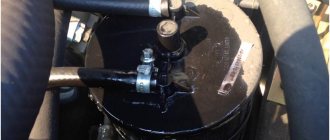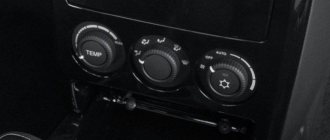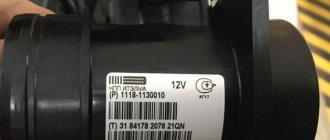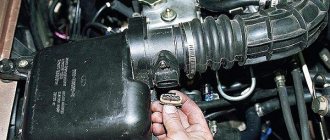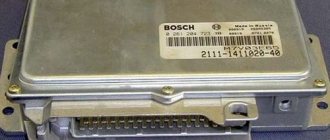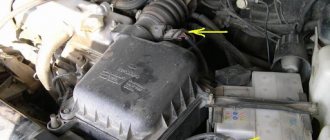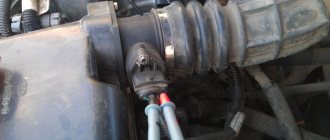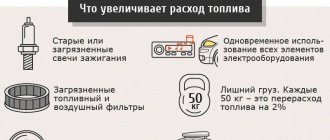DMVR is a mass air flow sensor, or as it is popularly called, a flow meter. It is designed to regulate the flow of air through the throttle body to create the fuel mixture. If this sensor fails, more or less air may enter the cylinders, which will affect fuel consumption. The cleanliness of the throttle also affects the flow rate.
The video shows the symptoms of a faulty mass air flow sensor on a VAZ. A non-working mass air flow sensor was specially installed:
What is a mass air flow sensor on Priora and its purpose
When the first injection engines appeared, a device such as a mass air flow sensor had a mechanical operating principle. Over time, it was deprived of moving parts, due to which it was called mechanical, and today it has a different principle of operation, and is called hot-wire. Why is this sensor needed on a car, and what important functions are assigned to it, let’s look at it in detail.
To understand the purpose of the MAF or MAF (Mass Air Flow) flow meter on a car, you need to remember how fuel combustion occurs in the engine, or rather, what the combustible mixture consists of. It consists of gasoline, which is supplied through the injectors, and air entering the intake manifold when the damper is opened. These substances are mixed in certain proportions, resulting in a fuel-air mixture that is burned in the engine cylinders. What does the mass air flow sensor have to do with the combustible mixture, you ask? The most direct purpose, because with its help the electronic control unit of the ECU receives information about the quantitative composition of the incoming air.
Based on this information, the ECU calculates how much gasoline needs to be supplied to each cylinder in order to create the optimal proportion or maintain a stoichiometric mixture. It is known that for complete and successful combustion of the air-fuel mixture, it is necessary to prepare it in the correct proportion, which is:
- gasoline - 1 kg.
- oxygen - 14.7 kg.
There is 1 kg of fuel per 14.7 kg of air, which is the optimal ratio and contributes not only to complete, but also to the most efficient combustion of the combustible substance. Faulty operation of the mass air flow sensor or the inoperability of this sensor will lead to a deterioration in the quality of engine operation, and in addition, the amount of harmful substances in the exhaust will increase, because gasoline will not burn in full (which will shorten the life of the catalytic converter).
Gasoline to air ratio table
A fuel-air mixture in a ratio of 14.7 to 1 is needed not only to ensure a high level of engine efficiency, but also to increase environmental friendliness. With this proportion of fuel assemblies, catalytic converters suppress unburned substances as efficiently as possible, eliminating the possibility of their release into the atmosphere.
This is interesting! When a car accelerates, fuel assemblies are not prepared in the standardized proportion, which is an absolutely normal phenomenon.
Depending on the amount of incoming air and its density, the ECU calculates the duration of fuel injection through the injectors, which is supplied to the combustion chambers. It is this sensor on cars that is the most expensive, and it affects engine power, acceleration dynamics, as well as consumption, and, most importantly, the degree of environmental friendliness. When the mass air flow sensor on a Priora fails, the Check Engine indicator lights up on the instrument panel. In addition, the corresponding errors are displayed on the on-board computer.
In simple terms, the sensor transmits data to the ECU about the amount of incoming air, and the controller, based on this information, understands whether it has enough oxygen to create the optimal fuel assembly ratio. When the sensor begins to show incorrect data, the following picture occurs: the ECU believes that air is supplied in increased quantities, due to which the mixture is adjusted (the amount of gasoline injected increases). As a result, the mixture turns out to be enriched (although in reality less oxygen is supplied), which leads to increased fuel consumption and flooding of spark plugs.
Types and features of flow meters
Explanation of the abbreviation MAF - mass air flow sensor. The device is used in cars with gasoline and diesel engines. It is located in the intake system between the air filter and the throttle valve and connects to the engine ECU. If the flow meter is missing or faulty, the amount of incoming air is calculated based on the throttle valve position. This does not provide an accurate measurement, and in difficult operating conditions, fuel consumption increases, since air mass flow is a key parameter for calculating the amount of fuel injected.
The principle of operation of the mass air flow sensor is based on measuring the temperature of the air flow, and therefore this type of flow meters is called hot-wire anemometers. Structurally, there are two main types of air flow sensors:
- thread (wire);
- film;
- volumetric type with a rotary damper (at the moment practically not used).
We recommend: In what cases should we use a molybdenum additive?
Design and principle of operation of a wire sensor
Diagram of a wire mass air flow sensor
The filament air flow sensor has the following device:
- frame;
- measuring tube;
- sensitive element - platinum wire;
- thermistor;
- voltage transformer.
The platinum filament and thermistor form a resistive bridge. In the absence of air flow, the platinum filament is constantly heated to a predetermined temperature by passing an electric current through it. When the throttle valve opens and air begins to flow, the sensing element cools, which reduces its resistance. This provokes an increase in the “heating” current to balance the bridge.
The converter transforms the current changes into an output voltage, which is transmitted to the engine ECU. The latter, based on the existing nonlinear relationship, calculates the amount of fuel supplied to the combustion chambers.
Types of mass air flow sensors and the principle of their operation
There are two types of mass air flow sensors, which differ in design, but their operating principle is identical. These flow meters have the corresponding names:
- Threaded air flow sensor.
The principle of its operation is based on changing the resistance of a thread-like element made of platinum and connected to an electrical circuit. Voltage is applied to the thread, which causes it to heat up. The temperature of the filament is about 120-150 degrees, and it decreases as air passes through while the engine is running. The more the damper opens, the greater the air flow, the more the filament temperature drops accordingly. It is due to the voltage drop on the filament (from a change in the temperature of the passing air) that the quantitative composition of the oxygen sucked into the intake manifold is determined. - Film mass air flow sensors or hot-wire ones
differ from the previous version in that they are more accurate, which has a positive effect on engine performance. The operating principle of such products is similar to the previous version, only they already have two platinum thermistors and one heating or compensation resistor (located between them). Thermistors work on a similar principle as filament sensors, that is, air passes through, cools the filaments, which leads to a decrease in resistance, and as a result, the voltage drops. The second thread is a heating resistor, which is located between the first and third threads, needed to heat the air. The result is the following picture: the first thread is cooled by the incoming air, and its resistance changes. The air that is already heated approaches the second thread, for which the resistor is responsible. Based on the change in the resistance of the first and second threads, the quantitative composition of the air entering the engine manifold is calculated. Due to this device, film products are not only more accurate, but also multifunctional, that is, they measure the amount of not only direct, but also reverse air flow.
It is important to note that instead of three threads, a plate (anemometer) made of silicon crystal can be used (plays the role of a heating resistor). Such a crystal is coated with several layers of platinum coating (thermal resistance), and performs similar functions as described above. Below is a diagram of a film sensor based on a silicon crystal.
The crystal is placed inside a protective casing, which is placed in a special channel (labyrinth). Moreover, the labyrinth has a special geometry, which makes it possible to take temperature measurements not only from the input flow, but also from the reflected flow. The specificity of the channel is created in such a way that the formation of dust and dirt deposits on the crystal is eliminated. The service life of products does not depend on their quality, but on factors such as the serviceability of the car’s crankcase gas exhaust system and the frequency of replacing the air filter. If the filter is not changed after 50 thousand km, then naturally not only the mass air flow sensor will suffer from this.
This is interesting! Film-type air flow sensors cannot be cleaned, but practice shows the opposite. If there are contaminants on the silicon crystal (sensitive element) of the film MRI sensor, they can be removed with special substances.
From the design and operating principle of both types of mass flow sensors, you can independently draw appropriate conclusions about their advantages and disadvantages. Naturally, the first type of sensors also has advantages:
- reliability;
- unpretentiousness.
And although there are not many advantages, they play an important role, which is reflected in their service life. Film flow meters, in addition to increased accuracy, are characterized by the ability to measure reverse air flow. Reverse flow occurs when the intake valves operate. However, film products have one serious drawback - they are not designed for cleaning when dirty. The reasons for their contamination are factors such as oil getting onto the surface, which comes from the crankcase gas system along with the reverse air flow, as well as contamination from the filter, which car owners change irregularly, although this must be done no later than every 20 thousand km. (in individual cases earlier).
This is interesting! Knowing the types of mass air flow sensors, it should be noted that Priors are equipped with products of the second type, that is, film ones.
The flowmeters are designed using a temperature sensor. It is called the DTVV intake air temperature sensor, which is a thermistor with a resistance dependent on temperature.
Depending on the temperature of the incoming air, the ECU adjusts the composition of the mixture (if the air is cold, the mixture is enriched, and when heated air enters, it normalizes).
Principle of operation
The piston stroke occurs when fuel is burned with air in a ratio of 1:14, maintaining which ensures optimal operation of the power plant. When the proportion decreases or increases, the engine does not stop working, but there is excessive fuel consumption or a decrease in engine operating power.
We need a mass air flow sensor so that air flows in portions. The operation of the unit proceeds as follows: the VAZ 2110 air flow sensor calculates the portion of fresh air, and then sends the data to the main computer, which, based on this information, calculates the portion of fuel.
https://www.youtube.com/watch?v=Ghzz6V5Ht3k
The harder you push the gas, the more filtered air the powerplant requires. The mass flow sensor detects the increase and commands the electronics to increase the amount of fuel. When moving at the same speed, each portion should be equal to the previous one.
The mass air flow sensor receives data on the load of the power unit, and then calculates the required portion of air. When the driver presses the pedal, the throttle valve opens, thereby increasing the volume of intake air - the load increases. When the pedal is released, the load drops.
What are the signs of a malfunction of the mass air flow sensor on the Priora and the corresponding error codes
The main problem with mass air flow sensors on Priora and other cars is contamination of the sensitive element. The more contaminants on the surface, the higher the level of error, which leads to incorrect readings received by the ECU. If the controller receives incorrect readings, then based on them the air-fuel mixture and advance angle are adjusted. Signs of a malfunction of the mass air flow sensor on a Priora are the following:
- Reduced power and vehicle dynamics.
If, when you press the accelerator pedal sharply, a deteriorated response is detected, then you need to check the mass air flow sensor. - Fuel consumption increases
. Moreover, its value can increase to 12-13 liters per 100 km. - It is difficult to start the engine or the engine may not start at all due to the spark plugs being flooded with fuel.
- Increasing or floating idle speed.
However, such signs can only indirectly indicate that the mass air flow sensor has failed. The corresponding error codes on the on-board computer of the Lada Priora will also help you verify that it is faulty:
- P0102 - a low signal level is received from the mass air flow sensor;
- P0103 - a high signal level is received from the mass air flow sensor;
- P0110 - malfunction of the air flow sensor circuit;
- P0112 - low signal level from DTVV (intake manifold air temperature sensor);
- P0113 - high level of DTVV signal.
The display of the last three errors indicates a malfunction of the thermistor, which is responsible for measuring the intake air temperature. If corresponding errors or the above-described symptoms are detected, it is necessary to resort to checking the condition of the mass air flow sensor on the Priora.
Prevention of DMRV malfunctions
Measures that will increase the service life of the controller:
- The air filter device should always be changed promptly. Its clogging is one of the main reasons why the flow meter fails.
- During operation of the vehicle, care must be taken to ensure that no traces of oil enter the air line. In particular, this is true for more worn-out power units.
- Periodically, it is necessary to diagnose the pipes for possible damage in the form of cracks and cracks. Their formation will cause contaminants and dust to enter the flowmeter.
- The power unit must not be started in the absence of an air filter device when the engine is being repaired.
- It is not allowed to use means such as “quick start” to simplify the start of an internal combustion engine for preventive purposes. Their use is possible only in extreme cases. The use of such products will harm the operation of the flow meter.
Why it is not recommended to clean the mass air flow sensor on a Priora and how to do it correctly
The mass air flow sensor cannot be repaired, so if it malfunctions, it must be replaced. However, there is an exception to this: if the DTVV fails, then the thermistor can be replaced by selecting the appropriate type depending on the resistance. If the sensor begins to show incorrect values, which happens if the silicon crystal is dirty, then it can be cleaned, but it is important to understand that such manipulations are only temporary, and soon the possibility of recurrence of problems with the mass air flow sensor cannot be ruled out.
Why is it not recommended to clean the film mass air flow sensor used on Priora? Let's look at this issue in depth. If you decide to clean the mass air flow sensor on a Priora, where a film type of product is used, then it is important to know the following:
- Such substances are strictly contraindicated for use for flushing. Like ketones and esters. This is due to the fact that they dissolve the compound layer that covers not only the board, but also the platinum branches connecting the crystal to the processor on the board. If the compound is dissolved, then thin branches (their thickness is less than 0.01 mm) will be damaged by passing air.
- When silicon comes into contact with ketones and esters, the wafer cools, which can ultimately be damaged.
- When exposed to the substances described above, the coating on the polymer film, which is located on the crystal itself, is also washed off. If the coating is washed off, the film is simply deformed.
- It is strictly contraindicated to blow or clean the product with a compressor (that is, you cannot apply a stream of compressed air to the crystal area), as this will lead to deformation of the branches.
If you are convinced that your air flow sensor on the Priora needs to be cleaned, then it is recommended to perform the procedure correctly. To do this, it is best to use the following substances:
- WD-40;
- "Liquid key";
- isopropyl alcohol;
- special liquid for cleaning the air flow sensor.
It is best to use a special cleaning liquid, but it is naturally more expensive than other cleaners. That is why, when choosing among budget cleaners, you need to give preference to isopropyl alcohol, since, unlike WD-40 and Liquid Key, it does not form an oil film on the surface, which will also need to be washed off. Preparations that are intended for cleaning carburetors and contain acetones, ketones and ethers are strictly contraindicated for use in cleaning the air flow sensor on a Priora.
This is interesting! Washing should be done using a syringe and a needle, from which you need to pour a thin stream onto the surface of the sensitive element.
Overview and characteristics of the mass air flow sensor
The sensor is connected to the electrical harness and is located in the intake tract. The signal from the mass air flow sensor is a direct current, which has its own voltage. The magnitude of the current depends on the movement of air in the Priora that has passed through the sensor. The Priora mass air flow sensor includes:
- a ring located inside the sensor, it is designed to fix the filter;
- the filter itself, located in the mass air flow sensor;
- inlet flange;
- different thermoelements;
- electronic board;
- contact connector;
- outlet flange.
3 thermocouples were installed inside the sensor. The first determines the temperature in the environment. Heating the air to the desired specific temperature is assigned to the next two thermoelements.
During the measurement of electrical power, the determination of the consumed air begins to occur. Electric power maintains the temperature at the desired level.
The filter that is installed in the Priora mass air flow sensor prevents large particles from entering the sensor housing. If this happens, the thermocouples may fail. It also has the function of cutting air to ensure even distribution of air. The filter is fixed with a ring intended for it in the inlet flange.
There is one rubber ring on each side of the housing for sealing. This is done to prevent air from being sucked in. Great importance should be paid to the seal ring located between the housing and the outlet flange located in the sensor.
If air begins to be sucked in, the system will not be able to take this into account, as a result of which the fuel mixture will become leaner. In this case, it is impossible to ensure maximum engine performance. It will be difficult to know that this is the problem with poor sensor performance. This will be difficult to do even with measuring instruments.
If foreign particles get into the mass flow sensor housing, it may fail. The MAF is a precise measuring device and, as has already been proven, does not tolerate anything hitting its body. The sensor on the car can be wire or film.
The mass air flow sensor on Priora is of the film type. The film is placed on a ceramic base. It contains both measuring and compensation resistors. These resistors are located inside the film. With this design, the sensor looks more reliable.
The film performs only the measuring elements. The substrate, in turn, functions as the strength elements of the structure. But such a sensor also has its drawbacks. Such sensors have a mechanical contact between the resistance track and the tire made of metal, resulting in wear.
DETAILS: Tips on how to reduce fuel consumption in a car - Financial Life
How to remove the mass air flow sensor on a Priora for cleaning: instructions for removing contaminants from the sensor and repairing the mass air flow sensor
If you decide to clean the mass air flow sensor on a Priora, then the first step is to remove the device from the car. Afterwards, you need to directly remove the sensor itself, which is built into a cylindrical body and is secured with two self-tapping screws. It would seem that it could be difficult to unscrew the screws and remove the air flow sensor itself. However, not everything is so simple, because the device is attached using self-tapping screws with a specific shape of the edges of the cap, so difficulties arise with unscrewing them. The photo below shows what the screw head on the Priora mass air flow sensor looks like.
This is interesting! The special shape of the screw head is made in order to eliminate the possibility of access to the working part of the sensor. Any interference with the design of the mass air flow sensor is unacceptable, as stated by the manufacturer.
It will not be possible to select a bat from a standard set, so there are three ways to solve the problem:
- find and order a special bit or screwdriver with the appropriate tip shape;
- Unscrew the screws using pliers;
- make cuts or notches on the cap in order to unscrew the screws with a screwdriver (it is recommended to do this only with a metal file, but not with a grinder).
Naturally, you should choose the second or third option. To do this, select the optimal version of the pliers (by size) and unscrew the fasteners. The photo below shows how this should be done correctly.
You need to unscrew the screws carefully and slowly, eliminating the possibility of strong vibrations of the sensor. After unscrewing the screws, you can begin to remove the device. After removal, it is important not to drop it, since the slightest impacts can lead to deformation of the working elements. Next, we proceed to the actual part of cleaning, which can be done using a can with an extension tube or a syringe with a thin needle.
To perform cleaning, there is no need to disassemble the unit, since during these manipulations the device can be damaged, and in addition, during reassembly, the seal may be broken. That is why, using a special liquid, it is necessary to treat the crystal and the thermistor with it (the TVB sensor if there are signs of contamination). Moreover, you only need to spray or pour liquids on them, but do not try to climb inside the channel (labyrinth) with a cloth or other objects in order to additionally wipe them. After treating with substances, you need to leave the part for 30 minutes so that it dries thoroughly, and then assemble and install in place. Test it in action in a car.
In order for the cleaning liquid to get onto the crystal, you need to spray it into the hole shown in the photo below.
Do not forget to wash the mesh of the cylindrical body, in which a lot of dust and debris may have accumulated. It can be placed in a bath of alcohol for a while to clean off any existing dirt.
If the DTVV, the location of which is shown in the photo below, fails, it can be replaced if the resistance value is known.
The malfunction of this semiconductor element can be determined by measuring its resistance. Below are the resistance limits depending on the air temperature.
If the multimeter shows a value above 100 kOhm, it means there is an open circuit. Do not forget that the presence of contamination on the thermistor leads to the fact that it begins to incorrectly determine the temperature. If the thermistor is faulty, it can be replaced using a soldering iron. The thermistor must be selected according to its resistance depending on the temperature, based on the table above.
You need to solder the thermistor with a short touch so as not to overheat the mass air flow sensor board. After such repairs, assemble the part and install the sensor in place.
How to repair a Priora mass air flow sensor?
The MAF costs a lot. According to the laws of the market, there are reasons for this. However, everything is much simpler! We have to pay a high price for the sensor due to our ignorance. Few people imagine how the mass air flow sensor works. Also, few people know why it stops working. Sellers always impose the opinion that if the mass air flow sensor starts to mope, then you definitely need to buy a new one.
The structure of the sensor is simple. But if you cannot find the fault in its malfunction, then it is better to visit a car repair shop. It is difficult to overestimate the role of the sensor. In order for the controller to monitor the uninterrupted operation of the ignition and injectors, it must more accurately know the air flow of the engine.
When repairing a Priora, the mass air flow sensor should be checked with a diagnostic device, the scale of which is up to 2 V. The wire from the device is inserted between the rubber seal and the yellow wire. Do this until the contacts rest. Measure the voltage at this contact point.
To do this, turn the ignition key. The ideal option is 0.99 V. When measuring, inaccuracy is allowed, but not more than 1.03 V. If the readings are higher, someone immediately runs to the store to buy a new sensor. But let's not rush.
Using pliers, unscrew the screws that secure the measuring element to the sensor. It is better to select self-tapping screws for a Phillips screwdriver. It will be easier for you to unscrew them in the future. Now you need to work with the removed element. Prepare washing equipment in advance. This will be an aerosol carburetor cleaner. Bend its tube at an angle of 90˚.
DETAILS: Do-it-yourself removal and disassembly of the Mazda 3Axela dashboard
To do this, heat the tube in the flame of a match. After this, cut it so that the tube itself is straight and the stream is directed to the side. Insert it into the upper valve of the removed element by 10 mm and rinse the resistor. Repeat this procedure after a couple of seconds.
Allow the cleaner to dry. Only then insert the sensor back into the housing. After this, the voltage measurement should be repeated. If during the measurement everything remained the same, then the mass air flow sensor on the Priora really did its job.
After flushing the sensor, some engine characteristics may change. In this case, it is worth checking the exhaust toxicity and adjusting it if necessary. If, during the check, the measurements returned to normal, then you can safely continue driving.
Not everyone wants to go to a service center and check the sensor to see if it is working properly, but some will simply feel sorry for the money. How can you find out for yourself whether the sensor is working or not without a service station?
To check the mass air flow sensor, you need to unscrew the clamp. This clamp secures the air intake corrugation. This action should be performed with a curved screwdriver. After the clamp has been removed, we begin to carefully remove the pipe. Inspect the surface of the pipe. Look inside the pipe, it should be clean and, of course, dry.
Using a 10mm wrench, unscrew the fastening elements of the mass air flow sensor in the Priora and inspect it. The rubber ring at the edge of the entrance should be in place. If this is not the case, correct it or replace it. If this is not done, then due to dust that gets into the sensor, it will stop working correctly.
If oil or traces of it were found in the design of the part, this will indicate that your oil sump is clogged, or that the concentration of lubricant in the engine is increased. In the first case, clean the system, and in the second, drain the excess oil.
How to remove and replace the mass air flow sensor on a Priora: which sensor to install on the car
The process of removing the mass air flow sensor on a Priora is not complicated, but it is important to understand that its dismantling must be performed not only when replacing it, but also if it is planned to be cleaned. Instructions for removing the mass air flow sensor are as follows:
- Disconnect the minus terminal from the battery. This is necessary in order to reset the ECU adaptation, or in simple words, reset the memory.
- The clamp securing the air duct pipe to the sensor is loosened.
- Disconnect the air duct pipe.
- Remove the power supply by prying the lock from below.
- Using a key set to “10”, you need to unscrew the two bolts securing the device to the filter housing.
- Remove the product so that it can be replaced, repaired or cleaned. However, it is worth noting once again that even if the cleaning is done correctly, the sensor will not last long after such repairs, and soon it will still need to be replaced.
This completes the removal process. Installation of a new product or the same sensor is performed in the same way. It is only important to take into account that if a new sensor is installed, then the O-ring must be removed from the old one and put on the new one. When reinstalling, you must pay attention to the arrow. It is in the direction of the arrow that the product must be placed. The bolts must be tightened with a force of 4-6 Nm, which will eliminate the possibility of damage to the fastening part in the air filter housing, and at the same time ensure sufficient pressure on the product.
This is interesting! It is recommended to remove the mass air flow sensor even if you have a special screwdriver for unscrewing the screws securing the sensor to the body. This is necessary in order to clean not only the sensitive element, but the housing of the ventilation duct with the mesh, on which a considerable amount of dirt has probably accumulated.
Symptoms of a problem
Since the sensor is electronic, and if it fails, the “CheckEngine” lamp will necessarily light up on the car’s dashboard. But not in all cases the sensor fails completely. When the sensor is dirty or old, it begins to incorrectly read the air volume, which significantly affects the formation of the air-fuel mixture.
In case of such a breakdown, the “CheckEngine” warning light will not light up.
Signs:
- Engine speed fluctuates;
- Difficulty starting in all temperature conditions of the internal combustion engine;
- Increased fuel consumption;
- Uneven engine operation at idle;
- Loss of vehicle dynamics;
If you detect such malfunctions on your car, you first need to inspect the air flow sensor.
Which mass air flow sensor to install on Priora
If the procedure for cleaning the MAF sensor element does not result in improved engine performance, and when checking the product, the multimeter shows inflated results, then only replacement will help. You should know that the mass air flow sensor costs from 3,500 to 5,000 rubles, and therefore it is the most expensive among the executive bodies of the ECU on a car. However, driving with a faulty product is also dangerous, because in addition to increased fuel consumption, the life of the internal combustion engine is reduced.
If there is a need to replace the mass air flow sensor on a Priora, then it is important to know that such sensors are available in different versions. You need to choose exactly the type that is installed on your car. And although all models are structurally the same, they still have differences in calibration, that is, in the readings that they transmit to the computer. They are produced by Bosch. There are the following types of MVR sensors on Priora, which are marked as follows:
- 0280218116;
- 0280218164;
- 0280218225;
- 0280218037.
Among all these sensors, there are no worse or better ones, and their main difference is calibration, that is, the shape of the signal that is perceived by the ECU. By marking, the sensors are not associated with the vehicle, but with the type of controller or ECU. Below is a table showing different models of mass air flow sensors used for certain types of controllers.
Once again, it is important to note that mass air flow sensors on Priora are not interchangeable, and you only need to install the type of device that was on the car.
This is interesting! When purchasing products, pay attention to the fastening parts that secure the sensor to the cylindrical body. To avoid buying a fake, you need to choose products with a ribbed surface, as shown in the photo below.
The packaging of a new product must contain a hologram. And it is precisely such devices that do not need to be checked before purchasing them.
In conclusion, it is worth noting once again the importance of the mass air flow sensor on a car. This sensor rarely fails completely, and most often, the malfunction manifests itself in the form of an increase in the output voltage supplied to the ECU. This is a slight increase (from 0.02 to 0.05V), but it is precisely such deviations that lead to the supply of inaccurate values of the incoming air mass to the collector. Monitor the serviceability of this product, and in case of the first signs of malfunction, carry out replacement or possible repairs in the form of cleaning.
How to check the performance of the mass air flow sensor
If characteristic signs of malfunction and failure of the air flow meter (MAF) appear in the engine operation, there are simple methods to check its performance and determine the cause of the malfunction on your own. To do this, it is enough to understand the principles of operation of this sensor as a component of the system.
The electronic engine control unit regulates the fuel supply based on signals from the MAF sensor, and if it fails, it switches the system to emergency mode. Gasoline supply begins to be calculated based on the readings of the throttle position sensor and crankshaft sensor, however, the fuel injection parameters based on these data are very approximate. On some cars in this mode of engine operation, idle speed increases to 1500-2000 thousand.
To perform self-diagnosis, it is enough to disconnect the MAF sensor chip with the engine running. If this is accompanied by an increase in the speed of the power unit, the sensor is working. But on some car models this may not happen, so you need to do a test drive and pay attention to the car’s behavior. If the acceleration dynamics have noticeably improved, then the problem is really in the mass air flow sensor.
Additionally, it is worth carrying out control measurements with a high-precision multimeter, if available. The check is carried out with the engine not running and the ignition on. The voltage readings at the output of a working sensor should be within the limits of 0.9 to 1.4 Volts; exceeding this threshold usually indicates a malfunction of the unit.
How the air flow sensor looks and works in a Lada Priora car
Communities Lada Priora Lada Priora Club Blog What tie rod ends are on Priora
In some ways it resembles a wind tunnel. Because of its shape. It is made in the form of a short plastic pipe with a diameter of about 5 centimeters. It can be divided into three parts:
- The body is in the form of a pipe.
- Sensor located on it.
- Protective grille and rubber gasket on the rim.
The connector for this sensor goes out. While the main, reading part is located inside. The basis of the device is a special thread made of an alloy of rare earth metals. In addition, the Priora air flow sensor has a heating circuit. This is done so that in winter the computer can quickly begin to receive signals from the device. After all, a frozen thread does not work correctly. The meaning of its operation and the principle of operation is to change the resistance of this thread depending on the speed of air passing through the nozzle. Based on these data, the Priora control unit (ECU) calculates the mass of air that has entered the cylinders over a certain period of time. That is, when the throttle valve opens, the flow increases accordingly. And the ECU calculates the fuel rate.
Important! This is the most expensive of the sensors in the entire Priora ECM and you need to treat it very carefully.
Where it is located
The sensor module is installed on the air filter housing near the battery in the Priora engine compartment. A rubber air duct tube is attached to it, leading to the throttle valve assembly.
Symptoms of a problem
The most unpleasant thing about this issue is that very often malfunctions of this device do not cause the “Check Anger” warning light to turn on. Meanwhile, it is the performance of this unit that ensures the uniform operation of the Priora engine. But there are many signs of a malfunction of this unit. These are:
- Sudden loss of power while driving.
- Increased fuel consumption of Priora.
- Jerks both while driving and at idle.
- “Swimming speed at idle.
- Difficulty starting.
Lots of signs. However, the problem is that they can also be caused by other reasons. Only qualified computer diagnostics can help here. After all, if the Check Anger light is not on and there are no errors in the memory, then only observing the linear parameters of the mass air flow sensor in the testing program will indicate inconsistencies in the air/fuel section.
Attention! The normal indicator in this area, for the Priora engine, is approximately 10-11 kg/min. Any deviation from this indicates a malfunction
In general, to be honest, hand on heart, we can say one thing: the most reliable test of this unit is to replace it with a known-good sensor.
Replacement
But this simplest operation is available to any car enthusiast. It is attached to the filter housing with just two No. 10 wrench bolts. And the rubber pipe is tightened with a screwdriver clamp. To replace this node, you just need to do a few steps:
- Disconnect battery.
- Disconnect the air flow sensor connector.
- Unscrew 2 bolts.
- Release the clamp and remove the device housing.
- Replace the rubber band with a new one.
- Reassemble in reverse order.
By the way, for example, any air leak in the intake system that appears in the area of the air duct located after this device affects the operation of the engine in the same way as a failed sensor. Therefore, it is necessary to take the diagnosis of this node very seriously.
Important! This device is very sensitive to moisture! There is a particularly high risk of damage when washing the engine. Because if ordinary water gets on the reading thread, it will ruin it with a probability of 50%, then liquid with any detergent additives will kill it by 100%.
Many users on the Internet advise “cleaning” the mass air flow sensor. This is fundamentally wrong and most often leads, on the contrary, to guaranteed failure.
The video demonstrates the operation of the machine with a faulty mass air flow sensor:
- Rain sensor on Priora
- Internal CV joint on Mazda 3-6 cars
- Internal CV joint of Golf 2-4 cars
- Internal CV joint of Passat B2-B6 cars
Replacing the air flow sensor
It is important to know
The mass air flow sensor is purchased for a specific car model. The use of analogues is not recommended, as this may lead to malfunctions of the device.
What will you need?
To complete the task you will need:
- key head with a knob;
- Phillips screwdriver;
- wrench 10;
- new mass air flow sensor.
Step-by-step instruction
| Image | Step |
| |
| The sensor is fixed with two bolts on the body of the filter device. To unscrew them, use a key or ratchet. | |
| After removing the last fastening, the regulator is dismantled. A new sensor is being installed, after which a chip with wires must be inserted into the mass air flow sensor. |
Examination
Checking the DMR is carried out using a multimeter, diagnostic tool or oscilloscope. In most cases, car enthusiasts do not have equipment that can diagnose sensor failure.
In this case, let's consider checking with a conventional multimeter, which almost every driver has or is otherwise inexpensive.
Checking the MAF with a multimeter can only be done with a sensor that is installed on an engine without an E-GAS system. It is impossible to check a frequency sensor installed in pairs with an electronic throttle valve using a multimeter. Such a sensor is checked using a diagnostic device using ADC channels or using a diagram on an oscilloscope.
You can also check the frequency sensor using the ELM327 diagnostic tool; read how to do this in our article.
Verification Process
To check the sensor you will need two needles and a multimeter. The principle of determining the performance of the mass air flow sensor is carried out by measuring the voltage between the contacts.
Checking the circuit
Initially, the sensor's power circuit is checked.
- We switch the multimeter to the DC voltage measuring mode at 20V.
- Remove the connector from the mass air flow sensor.
- Turn on the ignition on the car.
- We connect one of the multimeter leads to the motor housing, and the second to Pin No. 2 on the connector (there is a numbering of contacts on the block). The voltage at Pin No. 2 must be at least 12V.
- We carry out the same procedure with Conclusion No. 4. The voltage at Pin No. 4 must be at least 5V.
If the readings do not match and are significantly less than those indicated, you should check the battery, ECU and the air flow sensor power supply circuit.
Sensor check
Let's start checking the sensor; to do this, connect the mass air flow sensor connector if it is removed.
- We set the DC voltage measurement limit on the multimeter to 2V or 2000mV (in different versions of the multimeter, this value is indicated differently).
- We measure the voltage between terminals 1 and 3 with the car ignition on and off. We check the readings with the table below.
| Voltage (V) | State |
| 0.99…1.01 | Condition of the new sensor |
| 1.01…1.02 | The sensor is in good condition |
| 1.02…1.03 | Normal state of the air flow sensor |
| 1.03…1.04 | Needs replacement soon |
| 1.04…1.05 | The sensor practically does not work, it needs replacement |
| 1.05...and higher | The sensor is completely faulty and urgently needs replacement |
Also, one of the good checks of the mass air flow sensor is to replace it with a known good one, for example from another similar car.
MAF Lada Priora
LADA Priora cars were produced for more than 10 years, and were equipped with a range of engines of 6 modifications (4 of them with 16 valves). This does not mean that air flow sensors (MAF) are of the same variety. Together with the January 7 series and BOSCH M7 9.7 ECU controllers, the Priora engines were equipped with a mass flow sensor 0 280 218 116. Flow meters of this series are produced both by the German concern BOSCH and by numerous domestic and Chinese manufacturers. Differences in cost and reliability, and Russian products were most often equipped with electronic parts from the same BOSCH.
Mass air flow sensors installed on Priora with 16 valve engines have proven themselves to be reliable devices that do not fail without external reasons. In addition, in the event of a breakdown, flow sensors provide incorrect information for a long time with an error of 15–20%, which can be calculated from the following symptoms:
Sometimes (in 50% of cases) a faulty flow meter lights up the Check Engine light.
FakeHeader
Comments 53
a dying or dead air flow sensor is difficult to determine, the main indicators are increased consumption and unstable idle speed, it’s better to go to a normal diagnostician, if it shows not much more than one, then you can try to wash it with a carb cleaner, it may help
How to check the mass air flow sensor
Method number 1: Disable the mass air flow sensor. DMRV connector VAZ 2110 Disconnect the sensor connector and start the engine. If you turn off the MVR, the controller switches to emergency mode and prepares the fuel mixture only according to the throttle position. Engine speed must be greater than 1500 rpm. Let's try to go for a ride. If the car feels “faster”, then we can say that the mass air flow sensor is not working.
By the way, for ECU Y7.2, M7.9.7. The speed does not increase when the chip is turned off!
That's what I'm asking. Since it works in emergency mode, it pours fuel from here and rushes better, but the consumption is wild
Well, as much as I pressed, it flowed.
Well, gasoline is leaking. The mixture is rich and it starts to drive like a fool... and how does this explain that the sensor is faulty? After all, they say that if the dynamics improve, then you can throw away the MAF...
Well, as much as I pressed, it flowed.
Or am I missing something?
Or am I missing something?
FAQ on technical issues Lada PRIORA, here you can find answers to almost all questions.
How to check the mass air flow sensor
Method number 1: Disable the mass air flow sensor. DMRV connector VAZ 2110 Disconnect the sensor connector and start the engine. If you turn off the MVR, the controller switches to emergency mode and prepares the fuel mixture only according to the throttle position. Engine speed must be greater than 1500 rpm. Let's try to go for a ride. If the car feels “faster”, then we can say that the mass air flow sensor is not working.
By the way, for ECU Y7.2, M7.9.7. The speed does not increase when the chip is turned off!
But I can’t start without a mass air flow sensor, is that how it’s supposed to be?
No, the ECU should go into emergency mode anyway, unless the firmware is faulty.
it means I have a problem, since it won’t start
The engine should not start only if the DPKV is broken or disabled.
No, the ECU should go into emergency mode anyway, unless the firmware is faulty.
Is it necessary to do online firmware on a stock motor?
I have a stock one, but the ecu needs to be removed. Online you can change some parameters, but not flash it.
What happens with reduced or increased air flow?
Communities Lada Priora Lada Priora Club Blog Trouble check and blinking
You should definitely know that air affects not only the amount of fuel burned in the engine, but also the dynamic characteristics of the car. Therefore, deviations from the above standard indicators lead to the following consequences:
- if there is less air than needed, fuel is consumed more slowly. However, at the same time, dynamic characteristics decrease and engine power decreases;
- With increasing consumption, the dynamics increase, but the fuel burns much faster.
In addition, if the deviation is 2-4 kilograms from the norm in any direction, then the power unit may go into emergency mode and begin to work incorrectly.

